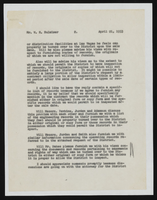Search the Special Collections and Archives Portal
Search Results
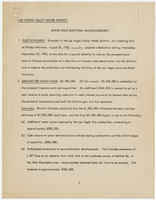
Bond issue election announcement by Las Vegas Valley Water District to eligible voters within district (Las Vegas), 1953
Date
1953-08
1953-09
Archival Collection
Description
Notice of special election for bond issue for the Water District including the reasons for the issue. Document includes information election date, amount of bond issue, voter eligibility, registration, purposes of bond issue, revenue, expenses, estimated water rates, financing, water consumption, and Lake Mead supply.
Text
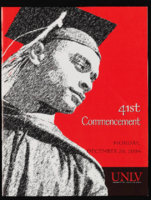
University of Nevada, Las Vegas (UNLV) 41st commencement program
Date
2004-12-20
Archival Collection
Description
Commencement program from University of Nevada, Las Vegas Commencement Programs and Graduation Lists (UA-00115).
Text
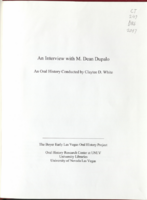
Transcript of interview with Martin Dean Dupalo by Claytee D. White, October 24, 2005
Date
2005-10-24
Archival Collection
Description
Martin Dean Dupalo was born February 20, 1967. His parents were Eva Auge, a German citizen, and Milton Dupalo. Martin shares many stories and anecdotes concerning his family background, his father's 21 year military career, his mother's tribulations in WWII Berlin, and the many sites the family visited all over the world. Martin gives a wealth of details regarding Las Vegas and UNLV in the seventies and eighties. He lists the schools he attended in Clark County and recalls some of the friends and professors his father knew while attending UNLV. Martin graduated from Eldorado High in 1985, attended UNLV, and was selected for a Truman Congressional Scholarship at Carnegie Mellon in Pittsburgh, Pennsylvania. He describes the house and surrounding area in which he and his father and brother, Michael Dean, lived. He also includes comments and anecdotes regarding entertainment in the Vegas Valley. After a stint as a fire fighter, four years in the Air Force and Air Force Reserve, and a brief marriage, Martin began teaching at UNLV in 2003. He discusses race relations as he has experienced them in his family, the military, Las Vegas, and at UNLV. His closing comments are in regard to war, world population, and the possibility of peace.
Text
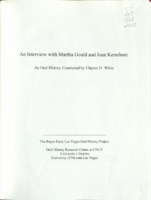
Transcript of interview with Martha Goulda and Joan Kerschner by Claytee D. White, October 26, 2005
Date
2005-10-26
Archival Collection
Description
Martha Gould and Joan Kerschner have been instrumental in most phases of library development in Nevada - from the branch to the state library. Their stories are fascinating and cover the techniques of moving a physical library to installing massive computer systems. They became librarians as young women and worked their entire careers in the field. Their memories add depth and profound meaning to the work of librarians. Gould grew up in a small mill town on the Sugar River and attended the University of Michigan. A librarian at Dartmouth College gave her a job and then insisted that she return to school for a master's degree. She earned her MS in Library Science from Simmons College. Kerschner hails from the Midwest, growing up in Abe Lincoln country. As a young girl, she went into their little Carnegie Library to rest and to view photographs on the stereograph while in town shopping with her family. She attended college across the river at Kentucky Wesleyan College and then earned a master's in library science at Indiana University. Martha and Joan have lobbied and testified before assembly committees to help bring libraries in Nevada to their current standing. This interview is about serious work told by two women, one who became state librarian, who look back over their many accomplishments with laughter and great joy.
Text
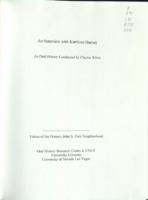
Transcript of interview with Kathleen Harney by Claytee D. White, July, 19, 2010
Date
2010-07-19
Archival Collection
Description
Kathleen and Tim Harney moved to the John S. Park neighborhood in 1975, about ten years after relocating from Ohio to Las Vegas, where teaching jobs paid more and the education system was more innovative. The Midwestern ambiance of John S. Park was attractive large trees and older homes among the outstanding features. In this interview, Kathleen laments the neighborhood changes that may be part of a normal aging cycle of any neighborhood as being more acute because of commercial changes on the Strip. Of the years they lived there, Kathleen speaks glowingly of the neighborhood's diversity—diverse in work schedules as much as in religion. She lists the various restaurants and describes the activities that drew the community together. It was a wonderful place to raise their girls who each graduated from Las Vegas High School. . As a passionate educator, she also speaks about the importance of schools, after school programs no matter what neighborhood one raises their children. And while the Harneys moved from John S. Park, she fondly recalls it as the place where she "really became a Las Vegas." It was the place where her family grew up and a place that "needs a little love" at this time. Special Note: Tim Harney, Kathleen's husband, and Kimberly Harney-Moore, their eldest daughter, are also participants in the Voices of the Historic John S. Park Neighborhood oral history project.
Text
Pagination
Refine my results
Content Type
Creator or Contributor
Subject
Archival Collection
Digital Project
Resource Type
Year
Material Type
Place
Language
Records Classification





